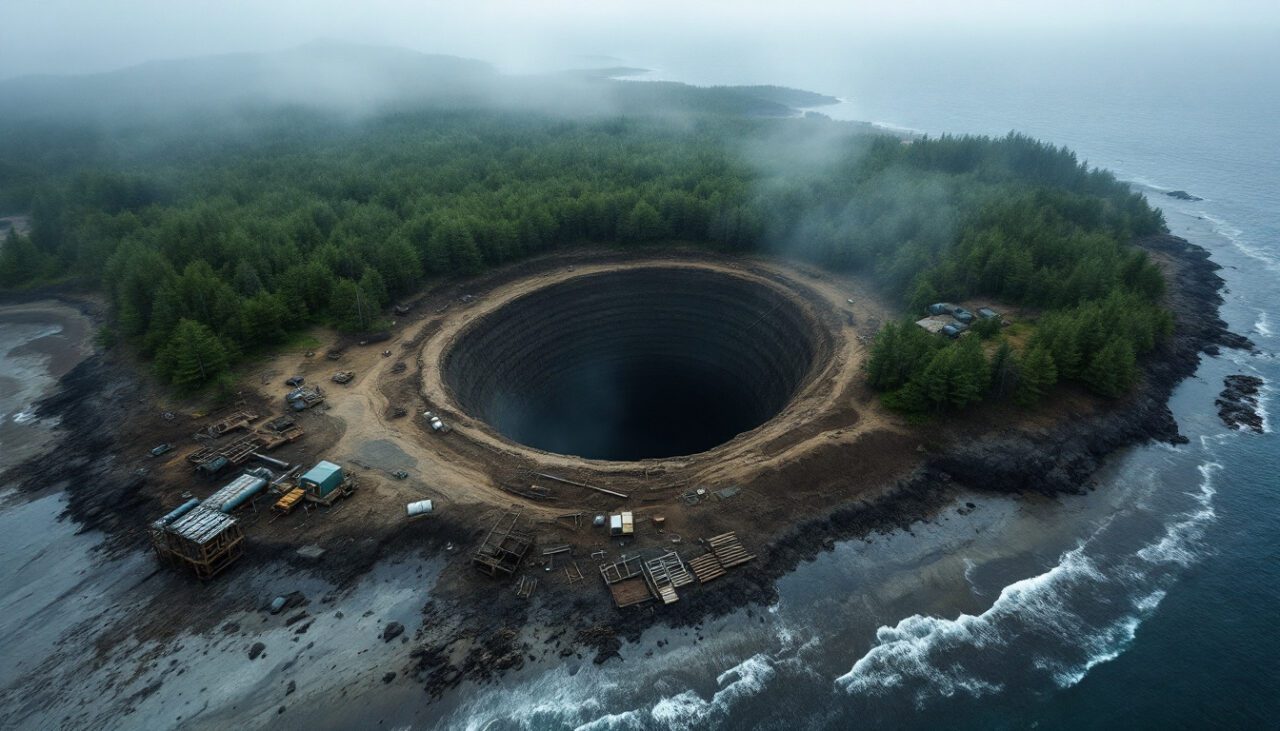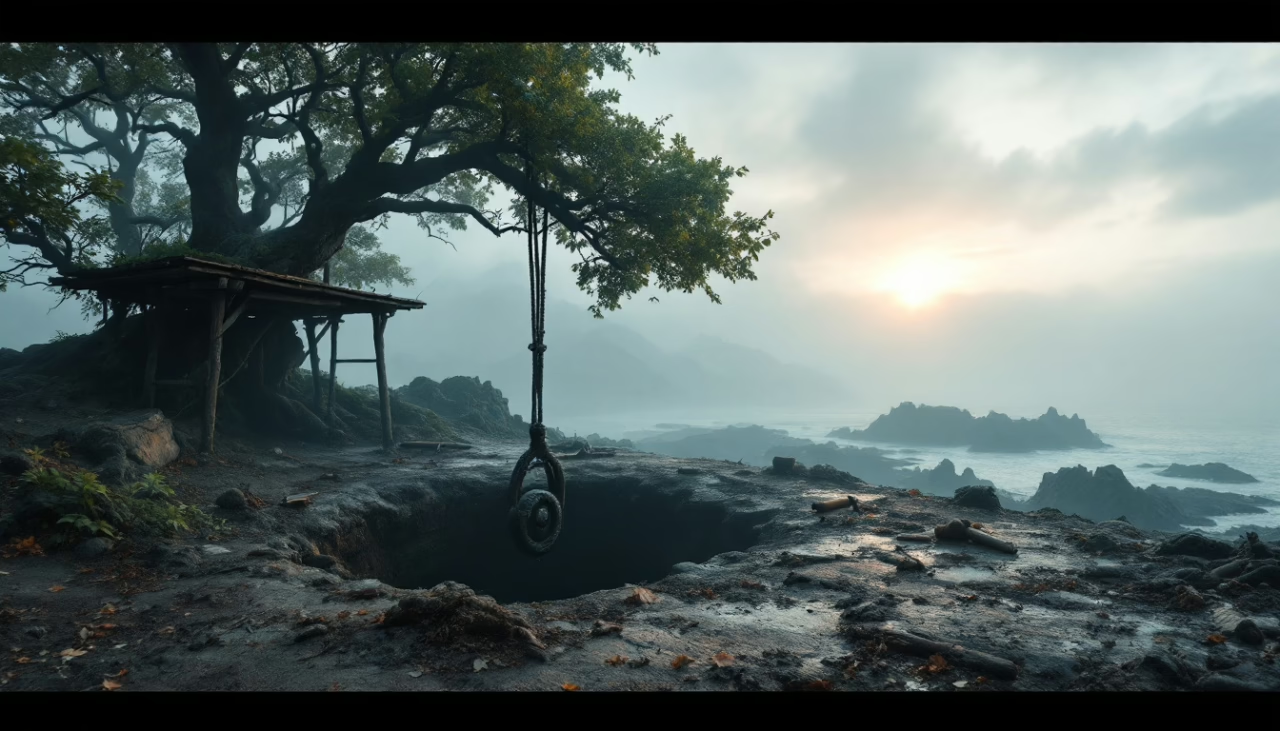Secrets Beneath Oak Island: The Oak Island Money Pit

Oak Island’s Money Pit: Truth or Tale? – The enigma of Oak Island’s Money Pit lies in its paradoxical nature—remarkably sophisticated yet frustratingly impenetrable.
Since its 1795 discovery, this marvel of engineering has confounded treasure hunters with its layered defense mechanisms: oak platforms, putty seals, and intricate flood tunnels that still function after centuries.
Historical records suggest meticulous construction predating modern equipment, raising questions about who possessed both the resources and motivation to conceal something of such apparent value beneath layers of maritime soil.
What secrets remain submerged beneath these calculated barriers?
TL;DR
Hide- The Money Pit discovery began in 1795 when Daniel McGinnis found a mysterious depression beneath an oak tree.
- Excavations revealed engineered platforms at 10-foot intervals, suggesting deliberate construction by skilled workers.
- An inscribed stone allegedly found at 90 feet translated to "Forty feet below, two million pounds lie buried."
- Complex flood tunnels connected to the ocean indicate advanced engineering that still challenges modern understanding.
- Despite centuries of excavation efforts, the true origin and contents of the Money Pit remain undiscovered.
The Oak Island: The Island That Started It All

Oak Island, a modest 140-acre landmass nestled within Mahone Bay off Nova Scotia’s southern shore, has captivated treasure hunters and mystery enthusiasts since European settlement in the 1750s.
The island’s transformation from obscure woodland to legendary treasure site began in 1795, when young Daniel McGinnis spotted an unusual circular depression beneath an oak tree, complete with a tackle block suspended from a nearby branch.
McGinnis’s adolescent curiosity, sparked by tales of pirates who once prowled these waters, would unwittingly launch one of history’s most enduring and expensive treasure hunts, spanning more than two centuries of excavation, speculation, and occasional tragedy.
Location and Early History of Oak Island
Located off Nova Scotia’s southeastern shore, Oak Island remains one of North America’s most enigmatic landmasses, enthralling treasure hunters and mystery enthusiasts since the late 18th century with tales of buried riches and strange phenomena.
Indigenous Mi’kmaq legends spoke of the island long before European settlers arrived, describing it as a place where “spirits guarded great treasure” and where unusual lights could be seen flickering across its densely wooded 140 acres.
The island’s reputation as a repository of secrets crystallized around 1795 when teenager Daniel McGinnis discovered a curious depression in the ground near a large oak tree—unwittingly initiating what would become the longest-running treasure hunt in recorded history.
Where Oak Island is and why it attracted attention
Nestled off the rugged coast of Nova Scotia, Canada, the modest 140-acre landmass known as Oak Island has captured the imagination of treasure hunters, historians, and conspiracy theorists for over two centuries.
Its distinctive geological features, documented in historical maps, coupled with persistent local legends, have attracted generations of determined treasure hunters.
The island’s archaeological significance lies in its mysterious “Money Pit,” discovered in 1795, promising unfathomable riches below.
Legends predating modern excavation attempts
Long before modern excavation equipment broke the island’s soil, whispered tales of buried treasure and pirate activity surrounded Oak Island, creating a mystique that would eventually draw fortune seekers from across the continent.
Indigenous stories intertwined with pirate legends, while ancient maps fueled speculation of vast riches concealed beneath the surface.
The folklore origins of these treasure myths remain debated among historians, blending documented accounts with embellished maritime tales.
The 1795 Discovery: A Teenager’s Curiosity
The summer of 1795 marked a pivotal moment in Oak Island’s history when teenager Daniel McGinnis, reportedly drawn to the island by strange lights, discovered a circular depression beneath an oak tree with a tackle block hanging from one branch.
Upon closer examination with friends John Smith and Anthony Vaughan, McGinnis uncovered unmistakable signs of human intervention: a layer of flagstones two feet below the surface, followed by carefully placed oak platforms at regular intervals as they dug deeper.
These engineered features—so methodically arranged in what would later be called the “Money Pit”—suggested not the random work of nature but a deliberately constructed shaft, meticulously designed by unknown hands for purposes that would perplex treasure hunters for centuries to come.
The story of Daniel McGinnis and the mysterious pit
In summer of 1795, a curious teenager named Daniel McGinnis forever altered the course of Canadian maritime history with a chance discovery that would launch one of North America’s most enduring mysteries.
Three critical elements surrounded McGinnis’ fateful discovery:
- A depression in the ground with signs of human disturbance
- An adjacent oak tree bearing marks of pulley rope damage
- Island folklore suggesting pirate activity in the area
First signs of artificial construction
Several peculiar findings emerged as McGinnis and his companions—Anthony Vaughan and John Smith—began excavating the mysterious depression.
Their rudimentary excavation techniques revealed unmistakable artificial structures: carefully placed oak platforms at regular intervals descending into the earth, contradicting natural geological formations.
This methodical arrangement, clearly man-made, electrified their treasure hunting ambitions and would later prove of immense historical significance to generations of explorers seeking liberation from ordinary existence through extraordinary discovery.
Strange Layers and Unusual Findings
Excavations of the mysterious “Money Pit” revealed an engineering marvel, with discoveries made at precisely ten-foot intervals, suggesting deliberate construction by skilled hands rather than natural formation.
Among the most compelling finds was a peculiar stone tablet, unearthed 90 feet below the surface, bearing symbols that have defied complete decipherment for centuries.
These cryptic markings, allegedly translating to “forty feet below, two million pounds lie buried,” have fueled both scholarly debate and treasure-hunting fervor, challenging researchers to distinguish between historical fact and embellished folklore.
Discoveries at 10-Foot Intervals
The excavation of Oak Island’s Money Pit revealed a series of deliberately engineered platforms at remarkably consistent 10-foot intervals, composed of logs, charcoal, and a mysterious clay-like putty that defied natural formation.
These constructed layers, bearing the unmistakable marks of human design, suggested an elaborate system created to either protect something below or, perhaps more intriguingly, to confound those who might attempt to reach it.
Archaeological analysis confirmed that such precise engineering required substantial knowledge of structural principles, indicating that whoever constructed these platforms possessed considerable technical expertise uncommon for the era in which they were believed to have been created.
Platforms of logs, charcoal, and putty
Layers of mystery unfold at regular intervals throughout the Money Pit, where diggers discovered platforms of oak logs positioned precisely every ten feet as they descended into the earth.
Excavation techniques revealed these archaeological findings:
- Log platforms, carefully constructed with hand-hewn timber
- Charcoal layers, suggesting deliberate burning or preservation methods
- Putty evidence containing traces of coconut fiber, inexplicably found in this North Atlantic location
Marks of deliberate engineering
Beyond these recurring platforms lies a remarkable pattern of engineering sophistication that defies natural explanation.
Excavation patterns reveal deliberate construction techniques at precisely measured intervals, suggesting historical methodologies far beyond colonial capabilities.
The architectural secrets—hewn stones arranged in geometric configurations, drainage systems redirecting water through cunningly designed channels—speak to engineering anomalies that have confounded experts for centuries, hinting at forgotten knowledge deliberately concealed beneath layers of earth.
The Stone with a Cryptic Inscription
Among the most enigmatic elements of the Oak Island mystery remains the legendary stone tablet, purportedly discovered at 90 feet deep in 1803, bearing symbols that translated to “forty feet below, two million pounds lie buried.”
The stone, examined by numerous scholars including Professor James Leitchi who claimed its symbols represented a substitution cipher, vanished mysteriously in the late 1800s after allegedly being displayed in a Halifax bookbinder’s shop window.
Its disappearance has fueled intense speculation about whether the inscription represented genuine instructions from the original depositors, an elaborate hoax designed to mislead treasure hunters, or perhaps a warning to those who would disturb whatever secrets lie beneath the island’s surface.
What the stone said and how it vanished
The mysterious inscribed stone, discovered at a depth of 90 feet within the Money Pit in 1803, represents perhaps the most tantalizing yet controversial artifact in Oak Island’s enigmatic history.
The stone’s archaeological significance extends beyond its physical presence, as it allegedly contained a coded message about treasure below.
- The inscription reportedly translated to “Forty feet below, two million pounds lie buried”
- The stone vanished in the 1930s after serving as a doorstep in a Halifax bookbinder’s shop
- Various translation theories persist, fueling Oak Island’s enduring mystery legacy
Theories about its translation and meaning
While the physical stone itself has vanished into history, scholarly debate surrounding its cryptic inscription continues to flourish with remarkable persistence.
Translation theories range from ancient Viking runes to medieval ciphers, while meaning interpretations oscillate between promises of buried treasure and warnings of historical significance.
Historical linguistics experts scrutinize every purported version of these cryptic messages, searching for cultural significance amid Oak Island’s enduring mysteries.
Flood Tunnels and Booby Traps
The mysterious Oak Island has confounded researchers with its elaborate system of water-filled chambers and traps, seemingly designed to protect something of immense value beneath its surface.
Excavation crews have repeatedly encountered intricate flood tunnels, engineered with remarkable precision, that fill excavation sites with seawater whenever diggers approach a certain depth in the Money Pit.
These sophisticated defensive mechanisms, constructed centuries before modern engineering capabilities, raise profound questions about who possessed both the technical knowledge and motivation to create such complex subterranean safeguards.
Water-Filled Chambers and Traps
The ingenious flooding mechanism of Oak Island stands as one of the most sophisticated engineering feats of pre-industrial times, triggering inundation whenever treasure seekers breach certain depth thresholds in their excavations.
Throughout centuries of exploration, numerous attempts to circumvent these watery defenses have employed increasingly advanced technologies, from primitive wooden dams to modern pumping systems and concrete barriers.
Despite these persistent efforts to block or redirect the network of flood tunnels, the mysterious hydraulic trap continues to protect whatever secrets lie beneath, suggesting either remarkable foresight by its designers or, as some theorists propose, a natural phenomenon misinterpreted as man-made.
The mysterious flooding mechanism
Perhaps most ingeniously devised of all Oak Island’s enigmas, the mysterious flooding mechanism has thwarted treasure hunters for over two centuries, filling tunnels with seawater just as excavators seem poised on the brink of discovery.
Three prevailing flooding theories include:
- Artificially constructed water channels connecting to Smith’s Cove
- Natural underground caverns repurposed as engineering puzzles
- Elaborate treasure protection systems utilizing multiple interconnected water mechanisms
Attempts to block or divert flood tunnels
Driven by mounting frustration and equipped with evolving technology, treasure hunters have launched numerous ambitious campaigns to neutralize Oak Island’s notorious flood tunnels over the past two centuries.
Historical attempts at flood control strategies ranged from rudimentary clay dams to sophisticated engineering innovations involving concrete barriers, pumping systems, and freeze walls—all facing insurmountable excavation challenges seemingly designed for treasure protection rather than merely natural phenomena.
Engineering Complexity Below Ground
The remarkable engineering beneath Oak Island extends beyond mere excavation, incorporating an intricate system of manmade shafts and tunnels that have confounded explorers for centuries.
Archaeological investigations have uncovered layers of coconut fiber—peculiar given its non-native status in Nova Scotia—suggesting sophisticated filtration systems or waterproofing techniques that remain unexplained by contemporary understanding.
These subterranean complexities exhibit construction methodologies that challenge modern engineering assumptions, hinting at advanced knowledge possessed by whoever designed this elaborate underground labyrinth.
Manmade shafts and tunnel systems
Numerous intricate shaft systems and labyrinthine tunnels honeycomb the subsurface of Oak Island, representing what many researchers consider the most compelling evidence of deliberate human intervention.
These underground engineering marvels defy simple explanation, challenging our understanding of historical excavation techniques.
- The Smith’s Cove flood tunnel, directing seawater into the Money Pit
- The 10X shaft, revealing mysterious manmade chambers via remote cameras
- The “Cave-in Pit,” connecting to previously undiscovered tunnel systems
Use of coconut fiber and unknown construction techniques
Enigmatic deposits of coconut fiber, discovered abundantly throughout Smith’s Cove, present archaeologists with a perplexing riddle about Oak Island’s construction methods and origins.
The material, inexplicably found hundreds of miles from native coconut habitats, suggests sophisticated ancient engineering knowledge.
Excavation materials reveal construction techniques far beyond colonial capabilities, lending historical significance to theories that advanced civilizations—perhaps Templar or Phoenician—employed methods lost to contemporary understanding.
Major Expeditions Through the Centuries
Through centuries of determined excavation, Oak Island has witnessed countless attempts to uncover its elusive subterranean secrets.
From the earnest explorers of the early 19th century to the fascination of President Franklin D. Roosevelt, who participated in the Old Gold Salvage group’s expedition in the 1930s, the search has drawn both amateur enthusiasts and powerful figures.
Modern efforts, spearheaded by the Lagina brothers and documented on television, have revolutionized the quest through advanced technology such as ground-penetrating radar, seismic testing, and sophisticated drilling techniques.
Yet the island guards its mysteries with the same tenacity that has frustrated searchers for over two hundred years.
Early 19th and 20th Century Digs
The calamitous pursuit of Oak Island’s secrets intensified during the 19th century when the Onslow and Truro companies launched systematic expeditions that combined entrepreneurial ambition with engineering ingenuity.
These early corporate ventures faced not only the mysterious flooding that plagued the Money Pit but also a series of devastating accidents that claimed multiple lives, giving rise to rumors of a curse protecting whatever treasure lay below.
The Onslow and Truro companies
Following the initial discovery by Daniel McGinnis and his friends in 1795, formal exploration of Oak Island’s mysterious pit commenced when the Onslow Company—a syndicate of businessmen and investors from Nova Scotia—launched the first organized excavation effort in 1804.
The historical rivalry between treasure hunting syndicates yielded three significant developments:
- Implementation of primitive but innovative excavation techniques
- Establishment of the Truro Company in 1845 after Onslow’s failure
- Documentation of mysterious artifacts that fueled subsequent expeditions
Tragedies, accidents, and ruined efforts
Despite early optimism surrounding Oak Island’s treasure hunt, a grim pattern of deadly accidents and devastating setbacks began to define expeditions throughout the 19th and 20th centuries.
The tragedy timeline includes multiple excavation accidents, with four workers dying in a boiler explosion in 1897, and continuous failed attempts due to flooding.
Historical misfortunes and mounting safety concerns eventually led many to question whether freedom from the island’s curse existed at all.
Franklin Roosevelt’s Interest in the Pit
Franklin Delano Roosevelt, long before his presidency, participated in the 1909 expedition to Oak Island as a young twenty-seven-year-old investor with the Old Gold Salvage group.
His fascination with the mysterious pit, which persisted throughout his political career, has fueled speculation about connections between the treasure hunt and his Masonic affiliations.
Scholars note the intriguing confluence of Roosevelt’s lifelong interest in maritime mysteries, his status as a 32nd degree Freemason, and persistent theories that Oak Island contains not just treasure but historically significant artifacts with potential Masonic significance.
The future U.S. president’s connection to the mystery
In 1909, a young man whose destiny would lead him to the White House became inexorably linked to one of North America’s most enduring mysteries.
Franklin D. Roosevelt’s involvement with Oak Island created profound historical connections through:
- Presidential intrigue as he invested financially in the Old Gold Salvage group
- Mystery fascination that persisted throughout his political legacy
- Treasure speculation that complemented his adventurous spirit
Freemasonry and theories tied to Roosevelt’s visit
Why would a future president of the United States, himself a 32nd degree Mason, develop such a profound fascination with a mysterious pit on a remote Canadian island?
Roosevelt’s curiosity likely stemmed from the site’s Freemason symbols and historical connections to secret societies.
His treasure hunting expedition in 1909 fueled speculation about Oak Island‘s significance to Masonic lore—perhaps containing knowledge that transcends mere monetary value.
The Lagina Brothers and Modern Technology
The Lagina brothers revolutionized the search for Oak Island’s secrets when their meticulous efforts became the centerpiece of Discovery Channel’s documentary series “The Curse of Oak Island,” catapulting the centuries-old mystery back into global consciousness.
Armed with unprecedented technological resources—ground-penetrating radar that peered through layers of earth and sophisticated sonar scans that mapped subterranean anomalies—they brought scientific rigor to what had previously been largely speculative excavations.
Their discoveries, including mysterious wooden structures, metal artifacts of uncertain origin, and tantalizing fragments of parchment, have simultaneously answered questions and deepened the enigma that continues to transform this small Nova Scotian island into an archaeological pilgrimage site for treasure hunters and historians alike.
Discovery Channel’s documentary and renewed global interest
When Discovery Channel premiered “The Curse of Oak Island” in 2014, few could have predicted how this documentary series would reignite global fascination with the mysterious Canadian isle and its purported buried treasures.
The documentary impact extended through:
- Exponential growth in global treasure hunts utilizing advanced excavation technologies
- Unprecedented audience engagement across demographic boundaries
- Enhanced cultural significance that transformed Oak Island from local legend to worldwide phenomenon
Ground-penetrating radar, sonar scans, and findings
Since acquiring the enigmatic treasure site in 2006, the Lagina brothers—Rick and Marty—have revolutionized the search for Oak Island’s secrets by deploying cutting-edge technological solutions where generations of treasure hunters previously relied on intuition and rudimentary tools.
Their systematic approach integrates ground radar, sonar technology, and geological surveys, producing detailed treasure mapping of subterranean anomalies while employing non-destructive excavation techniques that preserve historical integrity.
What Might Be Buried There?
The potential contents buried beneath Oak Island‘s enigmatic surface have sparked countless theories, ranging from pirate gold and Marie Antoinette’s jewels to Shakespeare’s lost manuscripts and Knight Templar relics.
Scientific researchers offer more mundane explanations, suggesting natural sinkholes, collapsed salt domes, or elaborate nineteenth-century engineering works rather than ancient treasures.
Between fervent believers and skeptical academics lies a fascinating historical puzzle that continues to captivate treasure hunters and scholars alike, challenging our understanding of what truly constitutes historical evidence versus romantic mythology.
Popular Theories on the Treasure
The enigma of Oak Island’s elusive treasure has spawned numerous theories about what might lie beneath its surface, ranging from the plundered riches of infamous pirates like Captain Kidd and Blackbeard to literary treasures such as lost Shakespearean manuscripts.
Religious artifacts command perhaps the most fervent speculation, with some treasure hunters convinced that sacred relics including the Ark of the Covenant or even the Holy Grail rest within the island’s labyrinthine underground chambers, awaiting discovery after centuries of concealment.
These theories, while varying dramatically in plausibility, continue to fuel the passionate excavation efforts that have transformed this modest Canadian island into an enduring archaeological obsession.
Pirate loot from Captain Kidd or Blackbeard
Perhaps no theory captures the imagination of treasure hunters quite like the possibility that Oak Island conceals pirate loot from notorious figures such as Captain William Kidd or Edward Teach, better known as Blackbeard.
Maritime folklore suggests three compelling connections:
- Historical artifacts matching pirate-era materials found in excavations
- Treasure maps with suspicious similarities to Oak Island’s topography
- Documented pirate legends linking both captains to Nova Scotia’s coastline
Lost manuscripts or Shakespearean documents
Why would literary treasures, rather than gold doubloons or silver pieces of eight, constitute the most historically significant find beneath Oak Island’s mysterious soil?
Some theorists propose that lost manuscripts—potentially Shakespearean—lie hidden in waterproof containers.
These literary clues, if discovered with verifiable historical authenticity, would revolutionize our understanding of Renaissance literature.
The treasure symbolism itself suggests knowledge, not mere wealth, may constitute the island’s true secret.
Religious relics: the Ark of the Covenant or Holy Grail
Beyond literary artifacts, an even more profound possibility emerges in Oak Island’s muddy depths: sacred religious relics that have captured humanity’s imagination for millennia.
- The Ark of the Covenant, with its immense historical significance and religious symbolism, represents the ultimate treasure legend—its disappearance fueling centuries of speculation.
- The Holy Grail, shrouded in medieval mystique, continues to embody mankind’s quest for transcendence.
- These ancient artifacts would transform Oak Island’s cultural impact from curiosity to revelation.
Skeptical Views and Scientific Explanations
While treasure hunters have pursued their quest for centuries, skeptical scientists offer more mundane explanations for Oak Island’s mysterious structures.
Geologists point to the island’s limestone foundation, suggesting that what treasure seekers interpret as man-made tunnels are actually natural sinkholes formed by water erosion, or perhaps the remnants of collapsed mining operations from the 1800s.
Archaeological experts have further challenged the treasure narrative, noting the absence of verifiable artifacts that would corroborate the elaborate theories, and emphasizing how natural geological processes can mimic seemingly intentional human engineering when viewed through the lens of wishful thinking.
Is it just a natural sinkhole or collapsed mineshaft?
Despite centuries of speculation and millions of dollars spent on excavation, the possibility that Oak Island’s famed Money Pit represents nothing more than a natural geological formation continues to challenge treasure hunters‘ dreams.
Geological evidence suggests three compelling explanations:
- Natural sinkholes from collapsed limestone caverns beneath the island
- Abandoned mining operations from early colonial resource extraction
- Glacial formations created during the last ice age’s retreat
Criticism from geologists and archaeologists
Professional geologists and archaeologists have consistently voiced skepticism regarding the treasure theories surrounding Oak Island, offering explanations grounded in scientific methodology rather than folklore or wishful thinking.
Their geological skepticism stems from evidence that the island’s features align with natural formations common in the region.
Scientific inquiry reveals that supposed artifacts often lack archaeological integrity when examined within proper historical context, suggesting treasure myths persist primarily due to confirmation bias rather than substantive findings.
The Ongoing Fascination
The cultural impact of Oak Island’s enigmatic treasure hunt has permeated countless media outlets, spawning bestselling books, television documentaries, and even a long-running History Channel series that draws millions of viewers each week.
Scholars, adventurers, and armchair detectives alike continue to debate the validity of various theories, creating a dynamic ecosystem of speculation that bridges academic research and popular imagination.
Despite two centuries of fruitless excavation and the deaths of six treasure hunters, the Oak Island mystery refuses to relinquish its grip on public consciousness, suggesting that perhaps the true treasure lies not in what might be buried, but in humanity’s enduring love affair with unsolved puzzles.
Media, Books, and Cultural Impact
The Oak Island mystery has transcended its geographical boundaries to inspire a wealth of media productions, including History Channel’s long-running “The Curse of Oak Island,” numerous documentaries, and novels that speculate on the treasure’s origins.
Visitors flock to the small Nova Scotian island, where guided tours offer glimpses of the Money Pit area, interpretive centers explain the various theories, and local museums display artifacts allegedly recovered from excavation attempts.
This cultural phenomenon, growing steadily since the 1960s, demonstrates how effectively the perfect combination of historical ambiguity, possible pirate treasure, and engineering enigmas captures the collective imagination of generations.
How the story inspired films, novels, and shows
Perhaps nowhere in popular culture has a treasure mystery captivated audiences quite like Oak Island’s enigmatic story, which has inspired countless media adaptations across decades.
The island’s cultural impact manifests through:
- Film adaptations exploring treasure-hunting narratives, including documentaries examining historical possibilities
- Literary inspirations spanning fiction, historical investigations, and speculative narratives
- Television series like “The Curse of Oak Island,” which transformed the storytelling legacy into mainstream entertainment
Public tours and tourism on Oak Island
Sprawling across twenty-one hectares of oak-studded landscape, Oak Island has transformed from an obscure treasure hunting site into a thriving tourist destination that draws thousands of visitors annually.
Guided excursions offer historical tours of excavation sites, while nearby local attractions complement the island’s appeal.
Visitors engage in educational treasure hunts that combine archaeological intrigue with tourist activities, satisfying both scholarly curiosity and adventurous spirits seeking connections to centuries-old mysteries.
The Mystery That Refuses to Die
The enigma of Oak Island continues to captivate researchers and enthusiasts alike, who remain drawn to its unsolved puzzles despite centuries of frustration and financial ruin.
Modern technology has invigorated exploration efforts, yet paradoxically, each new discovery seems to generate more questions than answers, fueling rather than extinguishing public fascination.
The island’s labyrinthine network of tunnels, ambiguous artifacts, and persistent legends create a perfect storm of mystery that resists conclusion, becoming an enduring reflection of humanity’s irrepressible desire to uncover hidden truths, even when they remain tantalizingly out of reach.
Why people are still drawn to it
Despite nearly two centuries of excavation and exploration, Oak Island’s allure has only intensified with each passing decade, drawing multitudes of treasure hunters, researchers, and curiosity seekers to its mysterious shores.
The historical allure persists through:
- Unresolved treasure legends that fuel our innate human curiosity
- Cultural fascination with unsolved mysteries across generations
- The adventure spirit that promises freedom through discovery, beckoning those who resist accepting conventional explanations
Unanswered questions and unfinished digs
Why, after countless excavations and millions of dollars invested, does Oak Island continue to guard its secrets with such tenacity?
The unresolved mysteries persist despite advanced excavation challenges, leaving treasure hunting enthusiasts perpetually on the brink of discovery.
Oak Island’s historical significance grows with each abandoned shaft and partial finding, transforming visitor experiences into pilgrimages toward freedom—freedom to unearth what authorities cannot explain or comprehend.
Wrapping Up
The Money Pit remains an unsolved enigma, defying definitive explanation despite centuries of investigation.
Recent core samples suggest the presence of human-made structures predating colonial settlement, lending credence to the Templar theory long dismissed as mere fantasy.
Whether treasure awaits or not, Oak Island’s true value may lie in its capacity to challenge our understanding of history, inspiring generations to question what secrets still lie beneath our feet.





